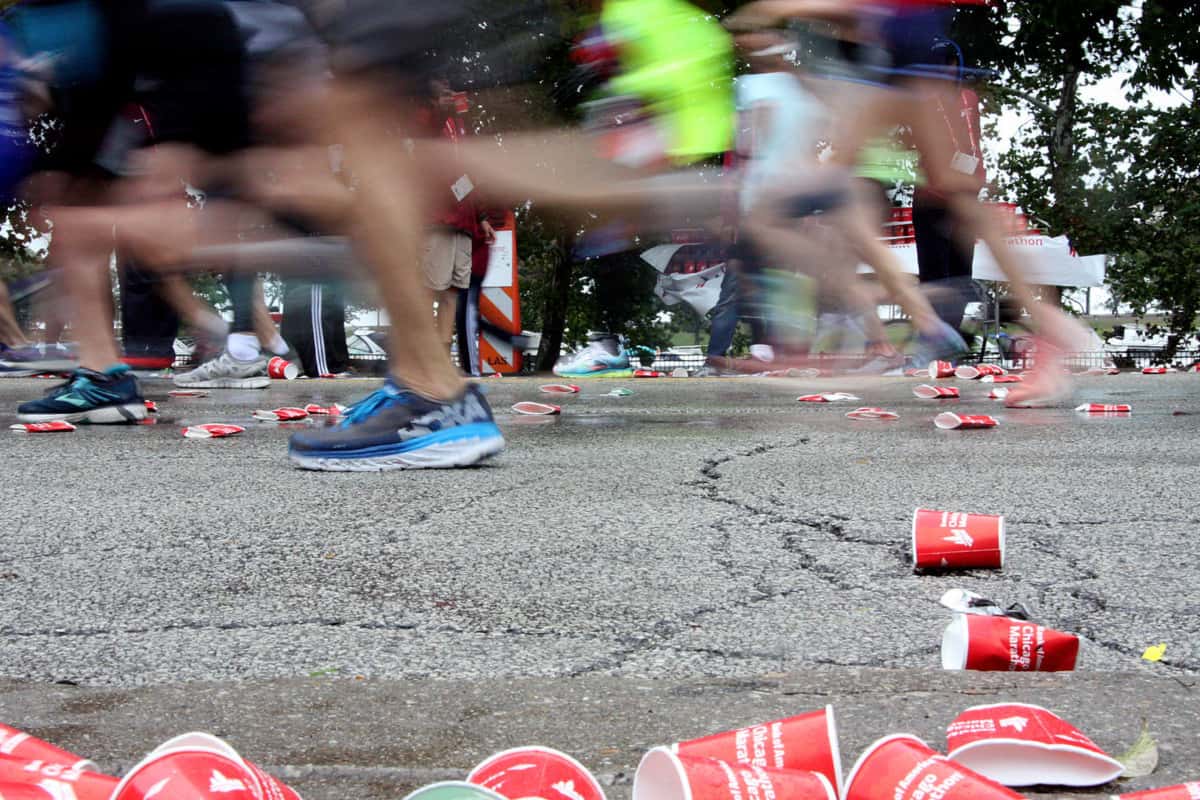Other than all those miles you have to run during marathon training, trying to figure out how to best fuel those runs might be the next hardest part. Because every person’s needs are different, nailing your marathon nutrition can take a lot of trial and error.
In order to be the best endurance runner you can be, you need to be fueling in a way that allows you to replenish the energy you burn while running long. Perhaps most important is determining what foods (fuel) to eat during your marathon.
But before you actually race with your chosen nutrition, you’re going to need a lot of practice with it beforehand. Let’s talk about how to choose foods that will fuel you best on your training long runs, and ultimately, through the entire marathon.
Marathon Food Options Have Come a Long Way
What you eat pre-run and post-run matter significantly too, but because there are so many options for in-run nutrition, we’re keeping that as the focus here.
Just like anything else when it comes to sport, nutrition has come a long way in recent years. There’s been a lot of change even in the last 15 years since I ran my first marathon.
Circling back to 2005…
I had so many stomach issues that I ran into while training for my first couple of marathons. Looking back now, I think it probably stemmed from the Advil I was taking before those runs (read about the research on painkillers before running here), but I also don’t think what I was using for fuel was sitting well, either (or I just needed to take more time to train my stomach which we’ll discuss).
Back then, there were a couple of gel options with similar ingredients. That’s what everyone else used, so I did, too. And though those are still popular options that work for many, there’s a lot more to choose from now.
Having an array of nutrition options is great news for all of us. It ensures that we can find something that makes us feel good while giving us the running energy we need. But it can also be overwhelming trying to figure out what works best. I’ll help you break down the choices!
How to Nail Your Nutrition for the Marathon
In order to get your nutrition right for race day, you have to practice first. And there’s no better time to practice than those long runs that are imperative in marathon training.
Once you are training for endurance distances that include runs over 75 minutes, you need to start fueling. Remember that just because you can run a particular distance without fueling, doesn’t mean you should. Taking in the right nutrition for the run that you are doing will ensure that you have enough energy to finish the run strong and recover well afterwards. Plus, as we discuss in our Half Marathon Nutrition Guide, you have to practice for race day. And that happens in training.
Why do runners need to take in fuel for long runs and the marathon?
The goal behind fueling is to have a steady supply of glycogen for your body to utilize.
When we run, we use up energy (in the form of glycogen) stored in the muscles during exercise. Consuming carbohydrates during a run (as well as before) will help replenish glycogen stores and provide the energy needed to continue running.
When runners don’t fuel properly, maintaining energy levels becomes difficult. Hitting the “wall” or bonking is likely inevitable. This is when your body can no longer sustain a pace and you end up slowing down a lot, needing to walk or stopping altogether. I go into this in depth in my article, “Hitting the Wall in a Marathon and How to Prevent It.” It’s not fun and you want to avoid this happening.
It’s necessary to take in carbs early on in your run as opposed to waiting until you are hungry to keep energy levels high.
How much fuel should I be taking in?
Now that you know fueling is really important, you’re probably wondering how much you actually need. Though the number of carbs necessary to take in during a run varies from person to person, most people are way under fueling.
Taking in anywhere from 50-90 grams of carbs per hour while running is a typical range for most. This is the equivalent of about 2-3 gels per hour, with one gel having about 20-25 grams of carbs. You’ll have to see what works best for you; this is why practicing your fueling during training is so important.
Let’s talk about your different options to get you the carbs you need to get your best marathon performance.

Different Types of Marathon Nutrition/Fuel
Options are great to have, right? Except when they completely overwhelm you. My best advice is to keep your nutrition as simple as possible while still finding what works best for you. Some runners use a combination of foods or products at set times through their run, but this will take practice. Other runners like the simplicity of finding the one product they know their body tolerates best.
When choosing your training and racing fuel, you’ll want to pay attention to:
- form the food/nutrition comes in (liquid, powder/liquid, gel, chew, etc.)
- grams of carbs per serving
- ingredients
Once you find what works, stick with it! Just because someone else uses something different than you do doesn’t mean there’s is better. If you feel good and don’t feel drops in energy, then you have the right stuff.
Carbs Are Your Body’s Preferred Running Fuel
Carbohydrates are what will sustain you through your run. As I discuss in my article, “The Carbo-Load: Why do marathon runners do this?,” your body’s preferred source of energy is carbohydrates. These are stored in your body as glycogen. Your body will burn fat for fuel if it needs to, but for most people, burning glycogen is much more efficient. (PS – read that article if you’re not sure what to eat leading up to your race!)
This means you need to be consuming carbohydrates before and during your run to have the energy you need to make it to the finish line.
These come in two forms:
- Simple carbohydrates – quick absorption/digestion
- Complex carbohydrates – take longer to digest and help us feel fuller for longer
There are many choices for simple carbohydrates and is what’s most widely used. We’ll look at those top contenders as well as one popular complex carbohydrate option.
Simple Carbohydrate In-Run Nutrition
If you are taking the simple carbohydrate approach, then you will just eat an easily digestible breakfast before heading out (think bagel, banana, or oatmeal) before your long run.
Generally, with simple carbs you’ll want to begin taking them about 30 minutes – 45 minutes into your run and then around every 30 – 45 minutes thereafter. However, this is just a guideline and it’s best to experiment to see what works best for your body. With simple sugar intake comes the insulin spike, as discussed in this article from Harvard Health. Once you start taking carbs in, you’ll need to continue to keep that energy “high.”
Simple carbohydrates can get a bad rap, but when it comes to utilizing them for exercise performance they can be the perfect choice. Because of their easy absorption, they’re often much easier on the stomach. They also convert to glycogen quickly, making them a quick energy source for your body. Remember, you’re using these simple carbs immediately to convert to energy…it’s not the same as eating a bag of potato chips while watching TV.
In-Run Carbohydrate Fueling Options
Drink, chew, gel, “real” food…as long as it’s carb-based and it makes you feel good, you have a winner. Here are some top options.
Carbohydrate Drink
Both of these drinks offer the perfect mix of energy (carbs), electrolytes (salt, etc.) and hydration (you mix them with water). Basically, if this is what you choose, you don’t need anything else. And that’s why it’s what I use! Their ingredients are not the same, but have a similar profile.
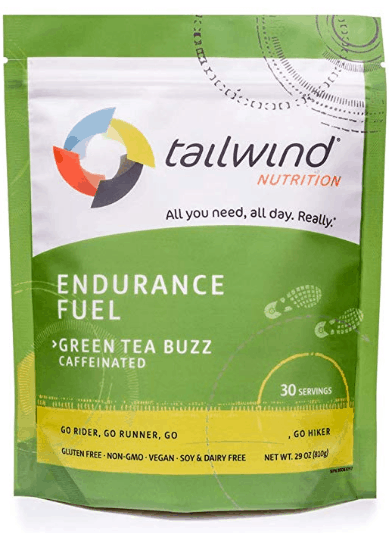
- Sword Endurance Drink – Their website states: “6% carbohydrate solution delivers about 60 grams of carbohydrate in every liter of SWORD® consumed – enough to make it the only carb source you’ll need in your marathon.” They recommend one 20-ounce serving of Sword per hour of running. I have had a lot of success with this as has my husband. This and water is all we use!
- Tailwind Endurance Fuel– The nutritional profile of Tailwind is similar to Sword, but it seems to be much more widely available. It’s in all of our local stores in Colorado, at least, and you can get it on Amazon. I know lots of people find similar success and I’m thinking of giving this a shot soon!
A benefit to a drink like Tailwind is that you are re-hydrating while taking in your carbs, but it’s a bit more tricky to carry. However, for your training runs you’ll have to carry water anyway; I share some different options for the best way in this article.
Energy Gels
There are lots of brands of gels. The ingredients vary widely, so if you go the gel route, be sure to stick to ingredients that your body is already used to.
Perhaps the most popular and widely used form of in-run nutrition is GU gel. In fact, many people just use the words “gel” and “GU” interchangeably even though GU is a brand (it’s been around since 1993). This is what I used to fuel all my long runs back in my 20s. These were not ideal for my husband and I, which is why we made the switch to Sword after wanting something that would be easier on our stomachs. This product overall has thousands of amazing reviews though and works well for a lot of runners.

Huma Energy Gels are a great alternative if you want a “real food” option in gel from. It’s essentially a fruit puree that comes in a packet like other gels. The simple ingredients make it something that could be much easier on your stomach: Strawberry Puree, Brown Rice Syrup, and Milled Chia Seeds are a few of the ingredients you’ll see in these.
Maurten is another option that has become widely popular in recent years – of course everyone became intrigued once they found out that Eliud Kipchoge used it to fuel his world-record performance at Berlin in 2018. Though expensive, runners enjoy this particular choice because it’s considered a “hydrogel” and it doesn’t need to be taken alongside water (though it’s still important to hydrate properly through your runs!)
Chews/Blocks
Some people prefer to chew something instead of downing the stickiness of gels. I much prefer these over gels for that reason.
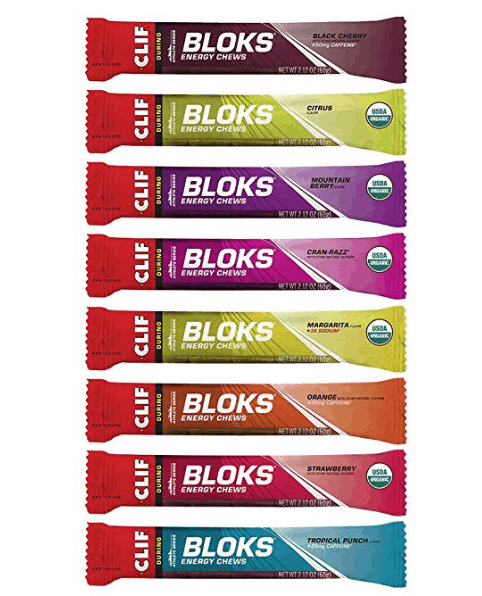
- CLIF Blocks – These are probably the most popular and they are widely available. They taste great and I like the consistency.
- Honey Stinger Energy Chews – If you’re looking for an organic option, Honey Stinger is a popular choice used by many. These have a honey base that is easily digested and has a lower glycemic index meaning the your blood sugar (and the “crash”) happen more steadily than sugars with a higher glycemic index (like sucrose).
- Homemade Paleo Energy Gummies – If you like knowing exactly what’s in your food and you enjoy cooking, this would be a great way to go. Here’s a good recipe from Eat the Gains.
Natural Food
If you want to go the “real food” route, fruit is going to be your best bet. Because fruit contains fructose, glucose, and sucrose, you’ll get the same type of energy that you would from any of the other simple carbohydrates above. If you prefer not to have added sugars in your diet and just overall feel better when you eat fruits in their purest form, then this is a great way to go. Some options that are easy to eat while running (and won’t make a mess) include:
- dried fruit (such as pineapple or mango)
- dates
- bananas
- applesauce pouches such as GoGo Squeez
- sweet potatoes or white potatoes (these can be cooked, chilled and then diced into chunks and I’ve been told are a hit among the ultramarathoner crowd)
With fruit, you’ll likely need more of it than you might think you need to get the same amount of carbs as some of the other options listed. If your body can handle it, then go for it! (It’s probably a lot more cost-effective, too).
Candy
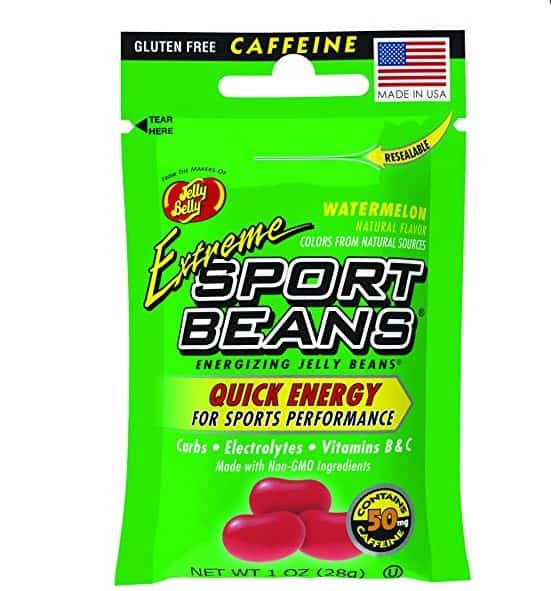
Personally I wouldn’t use candy as my only in-run nutrition source. However, I do think they can be a fun addition! It will give you something to look forward to, and late in runs, candy sounds amazing. (After burning through all your carb stores, this really isn’t at all surprising!) My favorites are gummy bears or jelly beans. (Of if you want the taste and feel of jelly beans but with added electrolytes, I really like Jelly Belly’s Sports Beans.)
What about caffeine? You’ll find that a lot of the nutrition that I listed comes in both a caffeinated and decaffeinated form. There is research that backs up caffeine’s ability to improve running performance which I wrote about here. Again, see what works for you! For myself, I down coffee before my run and stick with the decaf nutrition mid-run.
Complex Carbohydrate In-Run Nutrition
The choices in this category are much more limited. The allure of complex carbohydrates is that they give a steady supply. It takes your body much longer to break them down which means if you take enough before your run, you’re set for the majority of your long run or marathon.
UCan “SuperStarch”
This is what my running coach uses for his marathons and swears by it (he’s a sub 3-hour marathoner by the way!) It’s corn-starch based making it a complex carbohydrate. It gives a slow-release of carbs so you skip the blood sugar spikes you would get from taking something more simple. This is how it works:
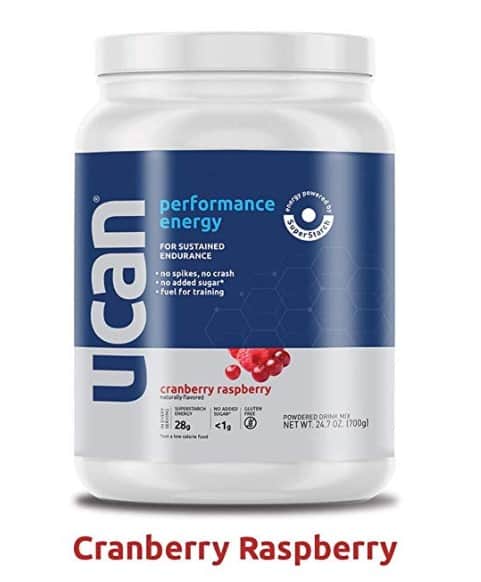
- Drink and finish about 30 minutes before your long run or marathon in shake form. Cornstarch based.
- It gives around 2-4 hours worth of energy – according to the website, 2 scoops will give 3 hours of energy.
- If you’re like most people and run a marathon longer than 2.5-3 hours, you might need to supplement with a gel later to get you through to the end of your marathon. Others will find that supplementing with water and a simple electrolyte drink (like Gatorade) will be enough.
Skratch Super High-Carb is another complex carbohydrate drink mix that gets great reviews. They share that it provides a “steady release of energy from Cluster Dextrin without gastrointestinal distress.”
What about electrolytes in fuel?
Some of the above products, like Sword and Tailwind, already include the electrolytes you’ll need to replace those lost while you sweat.
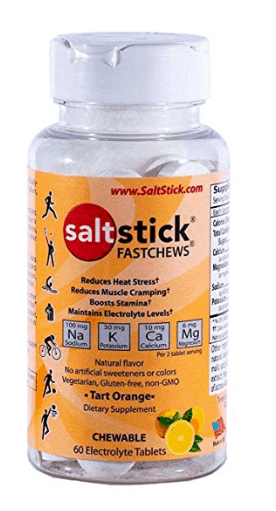
Otherwise, you’ll want to supplement with something like SaltStick Fastchews, Gatorade, regular salt tablets, or a salty food like pretzels. Especially when it’s warm out.
If you are sweating a lot, you will need electrolytes if your running nutrition doesn’t have them (look for sodium, potassium, etc.)
If you’re wondering if you can just take Gatorade as your nutrition for your long run, you could definitely try, but according to Runners Connect, it’s not the best option stating that gels are much more energy-dense than sports drinks. Supplementing for a bit of extra electrolytes works well for many, though. Nuun is another popular electrolyte drink that I really like that has a bit of a “cleaner” profile.
Bringing Your Own Nutrition Vs. Using What’s on the Marathon Course
As far as nutrition goes, I think most people bring their own to their race. When it comes to electrolyte drinks, I’d say it’s mixed.
In my article, “Carrying Your Own Water in a Marathon,” I talk about why I carry all of my own nutrition and water. Basically, I want to have everything available to me that I’ve trained with. And I can’t stand drinking out of a cup.
Unless you know what’s going to be on the marathon course you’ll be running (often this information IS posted on the race website) and have actually used it during your long runs, I would not chance using it on race day. If in a pinch you found yourself needing an extra gel or something, then by all means.
I strongly encourage you to figure out what nutrition works best for you on your longest training runs and then follow the same strategy on marathon race day (accounting for a little extra to get you through those last few grueling miles, of course!)
*Featured Image by Gregory Renaldo – Creative Commons
*As an Amazon Associate I earn a commission from qualifying purchases.
